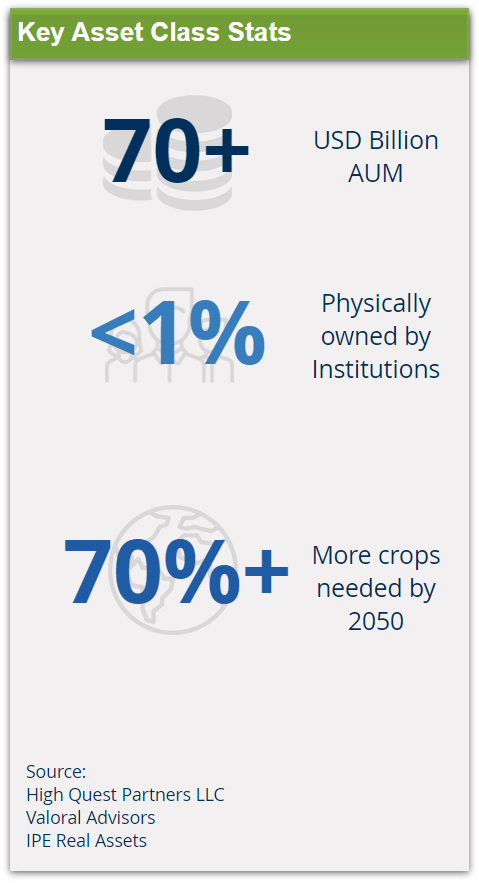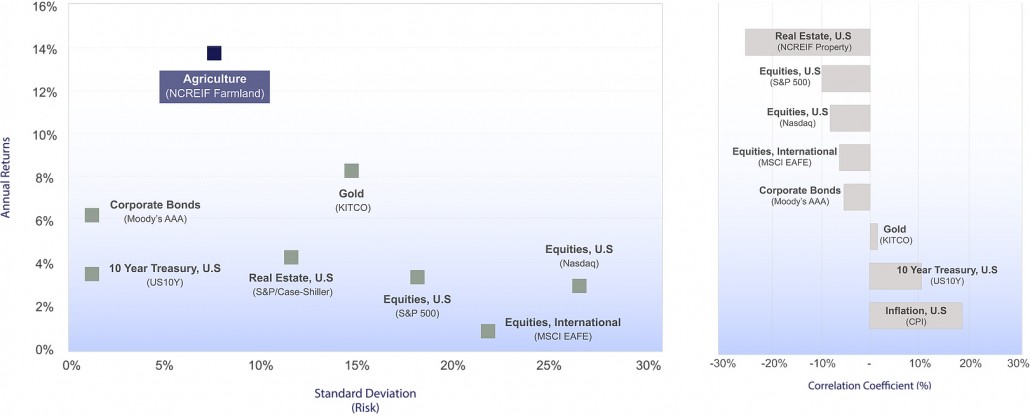Food and agriculture as an asset class falls under the broad investment category of real assets
which are physical in nature and 
To put this figure into perspective it is larger than the value of all gold ever mined and the global professionally managed real estate industry. A growing world population driving demand for high quality food coupled with a finite and decreasing supply of arable land means that the agricultural sector will only become more essential over time. There are three key ways investors can get exposure to the sector: by investing in funds that seek to create value by operating and enhancing the asset before exiting and realizing value; by purchasing commodity futures or directly buying and managing agricultural projects.
Between 2012 and 2019, the asset size of investments specializing in food and agriculture assets jumped from USD 24 billion to 73 billion, growing 25% p.a. Of this, the majority are indirect exposure holdings with over 60% held via commodities futures and equities. In terms of physical ownership, almost all investment into the sector at the moment is privately owned with institutional investment representing only 0.50% of total value. This is slowly changing as savvy institutional investors are beginning to take notice, but for most investors, the sector remains fragmented, confusing, and costly to enter.
Why Agriculture?
Agriculture has become an attractive investment destination for a number of reasons. Most important of all being the strong market fundamentals in support of the sector on both the demand and supply side. An increasing population, changing demographics, reductions in arable land and climate change have led to an urgent need of more productive methods of growing food.
There will be 9.6 billion people in the world by 2050, that will require more than 70% more crops than we have today. This combined with a reduction in arable land and the effects of climate change will result in sector over-performance.
Strong Returns
Agriculture has outperformed most asset classes throughout history, particularly on a risk basis when considering volatility. The NCREIF Index which is the world’s agriculture benchmark has yielded an annual return of 13.69% since 2000 with a standard deviation of only 7.58%. This far outperforms equities, real estate, bond and other asset classes. Performance is expected to improve further over the next decade due to strong demand supply fundamentals.
Inflation Protection
As food prices are closely linked to inflationary trends, owners of agricultural assets and those exposed to farming businesses possess a hedge against inflation. This is one key diversification benefit of the asset class.
Low Correlation with Other Assets
Agriculture has been shown to have low correlation with many other asset classes such as equities and corporate debt, which dominate the investment market. This means that including agricultural in a portfolio can provide significant diversification benefits, resulting in an increase in portfolio return or reducing overall portfolio risk.
Low Relationship with Economic Cycles
Population driven food demand remains the core base of demand for agricultural commodities. The demand for food is relatively inelastic to income, making demand for agricultural commodities less subject to an economic slowdown.
Agriculture vs. Other Asset Classes
Annual Returns & Correlations (2001-2021)

